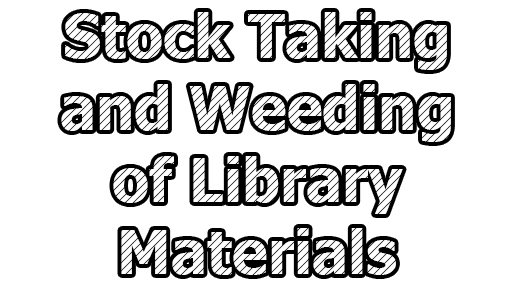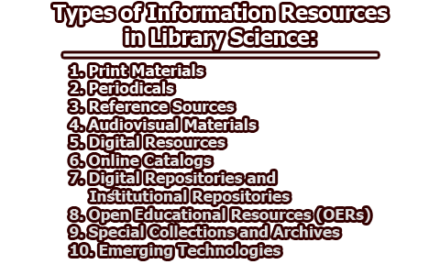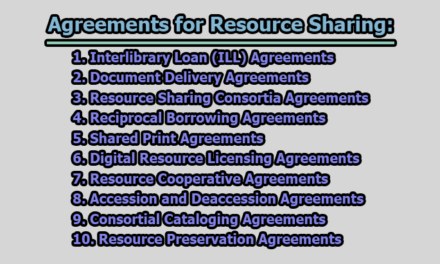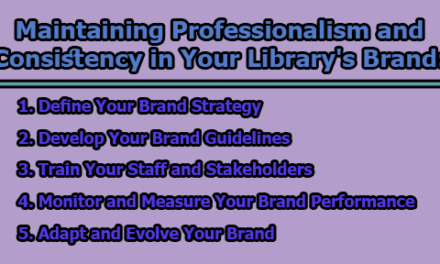Stock Taking and Weeding of Library Materials:
The process of stock taking and weeding of library materials is an essential aspect of modern library management. Libraries, be they academic, public, or specialized, are dynamic repositories of knowledge, constantly evolving to meet the changing needs of their patrons. To ensure the collection’s relevance, accessibility, and overall quality, librarians engage in systematic stock taking to assess the current holdings accurately. Simultaneously, weeding is employed as a strategic approach to remove outdated, damaged, or underutilized materials, making space for newer and more valuable resources. These twin practices, when conducted effectively, result in a well-organized and user-centric library environment. In this article, we delve into the principles and methods of stock taking and weeding, exploring their advantages, and also acknowledging the barriers that might hinder their successful implementation. By understanding the intricacies surrounding these processes, libraries can unlock their full potential, offering enriched experiences to patrons and paving the way for a thriving future of knowledge dissemination.
Principles and Methods of Stock Taking:
Stock taking in libraries is a crucial process that involves the comprehensive examination and assessment of the entire collection. It aims to ensure the accuracy, completeness, and overall quality of library materials. By conducting regular stock taking, librarians can gain a deeper understanding of the resources available, make informed decisions about collection development, and provide more efficient and effective services to library users. In this section, we will explore the principles and methods of stock taking in detail.
1. Principles of Stock Taking:
1.1. Accuracy and Thoroughness: The primary principle of stock taking is to achieve accurate and thorough data about the library’s holdings. This requires meticulous attention to detail and the commitment to examine every item in the collection. No item should be overlooked, as even a single missing or mislabeled item can lead to errors in the library’s records and compromise the integrity of the collection.
1.2. Regularity: Stock taking should be a recurring process rather than a one-time event. Regular stock taking ensures that the collection is continuously assessed and updated, allowing librarians to identify and address issues promptly. The frequency of stock taking can vary based on the library’s size, resources, and collection turnover rate, but it is generally recommended to conduct it at least once a year.
1.3. Collaboration and Teamwork: Stock taking is a labor-intensive process, and it is essential to involve a team of library staff in the effort. Collaboration fosters efficiency, reduces errors, and allows for a broader perspective during the evaluation. Assigning specific roles and responsibilities to each team member can streamline the process and enhance accountability.
1.4. Data Integrity and Security: During stock taking, librarians handle sensitive and confidential information about the collection. Ensuring data integrity and security is essential to maintain the trust of library users and safeguard the library’s reputation. Proper measures, such as password protection and restricted access, should be implemented to prevent unauthorized access or data breaches.
1.5. Technology Integration: Embracing technology is instrumental in modern stock taking practices. Library management systems and inventory management software can significantly streamline the process, making data collection, analysis, and reporting more efficient and accurate. Technology also allows for real-time updates, reducing the lag between stock taking and action.
2. Methods of Stock Taking:
2.1. Planning and Preparation: Before embarking on the stock taking process, librarians need to create a well-structured plan. This plan should outline the objectives, timeline, resources required, and division of tasks among the team members. Adequate preparation ensures that the stock taking process proceeds smoothly and minimizes disruptions to regular library services.
2.2. Data Collection and Inventory: The core of stock taking lies in the physical examination and verification of each item in the collection. Librarians use barcode scanners, RFID technology, or manual methods to collect data about items’ availability, location, condition, and accuracy of cataloging information. The collected data is then cross-checked with the library’s database to identify discrepancies.
2.3. Evaluation and Analysis: Once the data collection phase is complete, librarians analyze the results to identify missing, damaged, or misplaced items. They also assess the accuracy of cataloging information and identify any inconsistencies. The analysis helps in generating reports and insights that inform decision-making regarding collection development, budget allocation, and resource management.
2.4. Reporting and Action: The final step of stock taking involves creating detailed reports based on the data analysis. These reports should highlight the findings, including any discrepancies or issues that need to be addressed. Based on the reports, librarians can take corrective actions, such as updating the catalog, ordering replacement copies, or conducting further investigations into missing items.
Stock taking is an ongoing commitment that empowers libraries to maintain a well-organized and efficient collection. By adhering to the principles and utilizing effective methods, libraries can optimize their resources, improve user experience, and uphold their role as indispensable repositories of knowledge and information.
Principles and Methods of Weeding:
Weeding is a fundamental practice in library management that involves the systematic removal of outdated, damaged, or underutilized materials from the collection. It ensures that the library’s resources remain relevant, current, and useful to its users. Weeding not only optimizes physical space but also enhances the overall quality of the collection, making it more appealing and valuable to patrons. In this section, we will explore the principles and methods of weeding in detail.
1. Principles of Weeding:
1.1. Collection Relevance: The primary principle of weeding is to maintain a collection that is relevant to the needs and interests of the library’s users. Materials that are outdated, inaccurate, or no longer aligned with the library’s mission and goals should be systematically identified and removed. This process enables the library to present a curated selection of resources that meets the informational and recreational requirements of its diverse audience.
1.2. User-Centric Approach: Weeding decisions should be driven by the needs of the library’s users rather than arbitrary criteria. Librarians should conduct user surveys, gather feedback, and consider circulation statistics to gauge the popularity and usefulness of materials. Understanding the preferences and interests of the target audience ensures that the collection remains responsive to their evolving demands.
1.3. Collection Maintenance: Weeding is a proactive measure to ensure the ongoing maintenance and vitality of the collection. By regularly removing outdated or damaged items, librarians can prevent the accumulation of obsolete resources and allocate resources more effectively for the acquisition of new materials. This proactive approach helps the library avoid overcrowding and enhances the browsing experience for users.
1.4. Ethical Considerations: While weeding is essential for collection maintenance, librarians must approach it ethically and responsibly. Materials should not be removed based on personal biases or controversial subject matter. Instead, weeding decisions should align with established selection policies and professional guidelines. Additionally, consideration should be given to preserving historical or cultural significance, ensuring that valuable but underused materials are appropriately archived or transferred to relevant institutions.
1.5. Transparency and Communication: Weeding decisions should be transparently communicated to library users and stakeholders. Publicizing the rationale behind weeding actions fosters trust and understanding among the community. Librarians can also engage with users to explain the benefits of weeding, address concerns, and encourage feedback regarding the collection’s ongoing development.
2. Methods of Weeding:
2.1. Collection Evaluation: The first step in weeding is evaluating the entire collection to identify materials that no longer meet the library’s criteria for retention. Librarians consider factors such as currency, accuracy, relevance, physical condition, and duplication of resources during this evaluation process.
2.2. Criteria for Weeding: Libraries establish clear and objective criteria for weeding to ensure consistency in decision-making. Common criteria include:
- Currency: Materials that are outdated or superseded by newer editions or resources.
- Usage: Items with consistently low circulation or those that have not been checked out for an extended period.
- Physical Condition: Materials that are damaged beyond repair or pose a safety hazard to users.
- Relevance: Materials that no longer align with the library’s current focus or scope.
- Duplication: Multiple copies of the same title beyond the required number for user demand.
2.3. Weeding Techniques:
- Continuous Weeding: Libraries can incorporate weeding into regular collection maintenance activities, such as during reshelving or shelf-reading, to ensure a constant flow of updated materials.
- Rotational Weeding: This approach involves periodically evaluating specific sections or subject areas in the collection on a rotating basis. It prevents overwhelming library staff with a massive weeding task and ensures that all sections receive attention over time.
- Specialized Weeding Projects: Libraries may undertake targeted weeding projects focused on specific sections or formats to address unique challenges and opportunities within the collection.
2.4. Preservation and Disposal: Weeded materials should be handled appropriately based on their condition and value. Irreparably damaged items may need to be discarded, while valuable or culturally significant materials may be preserved in archival collections or donated to relevant institutions.
Weeding is an ongoing responsibility that empowers libraries to maintain a relevant, accessible, and high-quality collection. By adhering to these principles and utilizing effective methods, librarians can optimize the library’s resources, enhance user satisfaction, and reinforce the library’s role as a dynamic and vital source of information and knowledge.
Advantages of Stock Taking:
- Accurate Collection Assessment: Stock taking provides an accurate and up-to-date view of the library’s collection. By physically verifying each item’s presence and condition, librarians can identify missing or misplaced items and rectify discrepancies in the catalog. This accurate assessment enables the library to have a reliable database and a better understanding of the resources available for patrons.
- Improved Resource Allocation: Stock taking allows librarians to identify gaps in the collection and areas with excessive duplication. By understanding the distribution of resources, libraries can allocate their budget more efficiently. This leads to a better-balanced collection that caters to users’ needs, avoiding unnecessary spending on redundant or less popular materials.
- Enhanced User Experience: An accurately cataloged and organized collection results in a more positive user experience. Users can easily locate materials they need, leading to greater satisfaction and increased use of the library’s resources. Stock taking ensures that the library remains a user-friendly space, fostering a conducive environment for research, learning, and leisure.
- Collection Development and Planning: The data gathered during stock taking informs collection development decisions. Librarians can identify subject areas that require expansion, ensuring that the collection stays relevant to the community’s interests. Additionally, stock taking allows libraries to plan for future acquisitions and prioritize resources based on users’ demands and emerging trends.
- Compliance and Accountability: Regular stock taking promotes accountability within the library. It ensures that materials are properly accounted for and reduces the risk of theft or loss. The process can also help libraries comply with legal and regulatory requirements related to collection management and reporting.
Advantages of Weeding:
- Relevant and Current Collection: Weeding ensures that the library’s collection remains up-to-date and relevant to the needs of its users. Removing outdated and obsolete materials allows librarians to make room for newer, more accurate, and valuable resources. A current collection enhances the library’s credibility as a reliable source of information.
- Space Optimization: Weeding is essential for efficient space management. By removing materials that are no longer in demand or outdated, libraries can free up valuable shelf space. This optimization creates a more organized and less cluttered environment, making it easier for users to navigate the collection and find what they need.
- Enhanced User Access: A well-weeded collection improves user access to relevant materials. With fewer irrelevant or obsolete items, users can quickly find materials that match their interests or research needs. This streamlining of resources results in a more satisfying and productive library experience.
- Cost-Effectiveness: Weeding contributes to cost savings in collection maintenance. By removing items that are seldom used or have deteriorated, libraries can reduce expenditure on repairs, replacements, and storage. These cost savings can be redirected towards acquiring new materials or improving other library services.
- Collection Visibility: Weeding improves the visibility of the library’s valuable holdings. When materials are weeded, those remaining in the collection receive more attention, leading to increased circulation and usage. Weeding also helps librarians identify gaps in the collection and areas that require further development.
- Resource Sharing: Weeding can create opportunities for resource sharing among libraries. Materials removed from one library may be useful to another, fostering interlibrary cooperation and enriching collections across multiple institutions.
- Environmental Impact: By removing damaged or unusable materials, weeding contributes to environmental sustainability. Libraries can responsibly dispose of materials or engage in recycling initiatives, reducing their environmental footprint.
Barriers to Effective Stock Taking and Weeding:
- Insufficient Resources: One of the primary barriers to effective stock taking and weeding is a lack of adequate resources, including staff, time, and technology. Conducting thorough stock taking and weeding requires a significant investment of time and effort, which may be challenging for libraries with limited personnel or budget constraints. Without enough staff members to handle the workload, the process may be delayed, leading to inaccuracies and incomplete assessments.
- Resistance to Change: Implementing stock taking and weeding practices often requires a cultural shift within the library. Some staff members and stakeholders may resist the idea of removing materials from the collection, fearing backlash from users or believing that all items should be retained indefinitely. Overcoming resistance and fostering a mindset of continuous improvement can be a significant challenge in the successful implementation of these processes.
- Lack of Staff Expertise: Conducting effective stock taking and weeding requires a certain level of expertise and training. Not all library staff members may be familiar with best practices or possess the necessary skills for data analysis, collection evaluation, and decision-making. The lack of expertise can lead to inaccurate assessments and suboptimal weeding decisions.
- Complex Cataloging Systems: Libraries with outdated or poorly organized cataloging systems may face difficulties in conducting accurate stock taking. Inconsistent or incomplete catalog records can lead to discrepancies between the physical collection and the catalog, making it challenging to identify missing or misplaced items. Libraries may need to invest time and resources in updating and improving their cataloging systems before conducting stock taking effectively.
- Emotional Attachment and Subjectivity: Librarians and staff members may develop emotional attachments to certain items in the collection, making it difficult for them to objectively weed materials that are no longer relevant or in demand. Personal biases can hinder the process, leading to the retention of items based on sentimental value rather than their usefulness to the library’s users.
- Inadequate Policy and Guidelines: A lack of clear and comprehensive policies and guidelines for stock taking and weeding can impede the process. Without specific criteria and a well-defined plan, decisions may be inconsistent, leading to confusion and frustration among staff members and users. Establishing robust policies helps ensure consistency and transparency in the stock taking and weeding processes.
- Fear of Negative User Reactions: Libraries may fear negative reactions from users if certain materials are removed from the collection. Users may be attached to specific titles or subjects, and weeding decisions that are not effectively communicated can lead to complaints and a perception of reduced access to resources. Libraries must balance the need for continuous improvement with proactive communication to manage user expectations.
- Legal and Ethical Concerns: Removing materials from the collection raises legal and ethical considerations. Libraries must consider copyright, licensing agreements, and cultural heritage implications when weeding items. Preservation of historically significant materials and adherence to intellectual freedom principles require careful consideration during the weeding process.
- Lack of Time and Prioritization: Libraries are often faced with competing priorities, and stock taking and weeding may not always be given the attention they require. Staff may be occupied with other tasks, and these essential processes might be postponed or given insufficient time, leading to incomplete or rushed assessments.
Overcoming Barriers and Challenges to Effective Stock Taking and Weeding:
- Resource Allocation: Adequate resource allocation is essential for successful stock taking and weeding. Libraries should prioritize these processes by allocating sufficient staff, time, and budget. This may involve reallocating resources from less critical areas or seeking additional funding through grants or partnerships. Emphasizing the importance of stock taking and weeding to stakeholders and decision-makers can help secure the necessary support.
- Staff Training and Professional Development: Providing staff with training and professional development opportunities in stock taking and weeding can enhance their expertise and confidence in carrying out these tasks effectively. Training can cover data collection techniques, evaluation methods, and decision-making criteria. Staff should also be informed about the rationale behind weeding decisions and the benefits of maintaining a relevant and well-organized collection.
- Advocacy and Communication: Libraries can overcome resistance to change by actively advocating for the benefits of stock taking and weeding and communicating the importance of these processes to all stakeholders. Openly discussing the objectives, methodology, and outcomes of stock taking and weeding can foster understanding and support among staff, users, and the community.
- Collaborative Approach: Libraries can overcome barriers by adopting a collaborative approach to stock taking and weeding. Involving all relevant stakeholders, including library staff, administrators, users, and community members, can create a sense of ownership and shared responsibility for maintaining a high-quality collection. Collaborative decision-making can also lead to more informed and thoughtful weeding choices.
- Clear Policies and Guidelines: Developing clear and comprehensive policies and guidelines for stock taking and weeding is crucial for consistency and transparency. These documents should outline the criteria for weeding, procedures for data collection and analysis, and the roles and responsibilities of staff involved. Implementing these policies ensures that decisions are based on objective criteria rather than personal preferences.
- Piloting and Phased Implementation: Libraries can overcome resistance and challenges by piloting stock taking and weeding initiatives on a smaller scale before implementing them library-wide. Pilots allow librarians to identify and address potential issues before rolling out the processes fully. Phased implementation allows staff to gain experience gradually, reducing the workload and the risk of overwhelming the team.
- Engaging with Users: Libraries should engage with users during the stock taking and weeding processes. Seeking user feedback through surveys, focus groups, or comment cards can provide valuable insights into users’ preferences and needs. By involving users in decision-making, libraries can better align the collection with the community’s interests and expectations.
- Ethical Considerations: Libraries must navigate ethical concerns related to weeding by adhering to established professional guidelines and intellectual freedom principles. Consultation with subject matter experts, cultural institutions, or advocacy groups can help address concerns about the removal of culturally significant or controversial materials. Libraries can also create review committees to ensure a fair and thoughtful approach to weeding decisions.
- Technology Integration: Embracing technology can streamline stock taking and weeding processes. Implementing inventory management software, barcode scanners, or RFID technology can improve data accuracy and efficiency. Leveraging data analytics and visualization tools can also aid in identifying usage patterns and informing weeding decisions.
- Continuous Improvement: Overcoming barriers is an ongoing process that requires continuous improvement and adaptation. Libraries should regularly evaluate the effectiveness of their stock taking and weeding practices and be open to making adjustments based on feedback and changing needs.
It is apparent that stock taking and weeding are integral components of modern library management that play a pivotal role in maintaining an efficient, relevant, and user-centric collection. Stock taking ensures the accuracy and completeness of the library’s holdings, facilitating informed decision-making for resource allocation and collection development. Weeding, on the other hand, ensures a dynamic and up-to-date collection by removing outdated, damaged, or underutilized materials, optimizing space, and enhancing user access. Despite the challenges and barriers that libraries may face, proactive strategies such as resource allocation, staff training, clear policies, and user engagement can successfully overcome these obstacles. By embracing these processes and continually improving their implementation, libraries can deliver enhanced user experiences, cost-effective resource management, and a strengthened position as invaluable repositories of knowledge and information. Through the harmonious interplay of stock taking and weeding, libraries can remain vital and adaptive institutions, ever-ready to serve the evolving needs of their diverse and dynamic communities.
FAQs:
What is stock taking in a library?
Stock taking in a library refers to the process of conducting a comprehensive and systematic assessment of the entire collection. It involves physically verifying the presence and condition of each item in the library’s holdings and comparing the findings with the library’s catalog or database. The primary objective of stock taking is to ensure the accuracy, completeness, and organization of the collection, enabling libraries to make informed decisions about resource allocation, collection development, and user services.
Why is stock taking important in a library?
Stock taking is crucial in a library for several reasons:
- Accuracy: It helps ensure that the library’s catalog or database accurately reflects the actual collection, reducing discrepancies and inaccuracies.
- Resource Allocation: It provides data to make informed decisions about budget allocation and resource management, optimizing the use of available funds.
- Collection Development: It aids in identifying gaps in the collection and areas that require expansion or improvement, allowing librarians to curate a relevant and up-to-date collection.
- User Experience: An accurate and well-organized collection enhances user experience, as patrons can easily find the materials they need.
What is weeding in a library context?
Weeding in a library context refers to the deliberate and strategic removal of materials from the collection. The process involves identifying and removing items that are no longer relevant, accurate, or in demand by library users. Weeding ensures that the collection remains current, space is optimized, and users have access to high-quality resources.
Why is weeding necessary in a library?
Weeding is necessary in a library for the following reasons:
- Relevance: It ensures that the collection remains up-to-date and aligned with users’ needs and interests.
- Space Optimization: Removing outdated or underutilized materials creates space for new acquisitions and enhances the overall organization of the collection.
- User Access: A well-weeded collection allows users to find materials more easily, leading to improved user satisfaction and engagement.
- Cost-Effectiveness: Weeding helps libraries make efficient use of resources by eliminating unnecessary duplicates and preserving materials in good condition.
How often should stock taking and weeding be conducted?
The frequency of stock taking and weeding can vary depending on the size of the library, its collection turnover rate, and available resources. Generally, stock taking should be conducted at least once a year to ensure an accurate and up-to-date inventory. Weeding can be an ongoing process, integrated into regular collection maintenance activities, or done in targeted phases to address specific sections or subject areas.
What are some common challenges faced during stock taking and weeding?
Common challenges during stock taking and weeding include:
- Insufficient resources (staff, time, and budget) to conduct thorough assessments.
- Resistance to change from library staff or stakeholders.
- Lack of expertise or training in stock taking and weeding techniques.
- Complex cataloging systems leading to discrepancies between physical collection and database.
- Emotional attachment to materials, making it difficult to objectively weed certain items.
- Legal and ethical considerations regarding the removal of materials.
How can libraries overcome these challenges in stock taking and weeding?
Libraries can overcome challenges through various strategies, such as:
- Allocating adequate resources and prioritizing stock taking and weeding.
- Providing staff training and professional development in stock taking and weeding practices.
- Advocating for the benefits of these processes and communicating transparently with stakeholders.
- Adopting a collaborative approach involving library staff, users, and community members in decision-making.
- Developing clear policies and guidelines for stock taking and weeding to ensure consistency and transparency.
- Piloting and phased implementation to test and adjust the processes gradually.
- Engaging with users to gather feedback and align the collection with their interests.
- Addressing ethical considerations through consultation and review committees.

Library Lecturer at Nurul Amin Degree College










